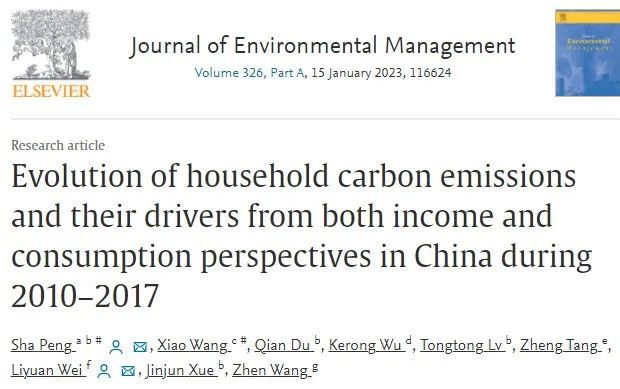近日,名师团队成员彭莎副教授(第一作者)在《Journal of Environmental Management》发表论文《Evolution of household carbon emissions and their drivers from both income and consumption perspectives in China during 2010–2017》。该刊目前中科院分区一区大类Top期刊,JCR分区一区期刊,影响因子为8.910。

基于此,本研究首先应用双比例尺度法(RAS)获得了2010-2017年的时间序列投入产出表。然后将结构分解分析(SDA)与Ghosh和Leontief 投入产出分析(IOA)相结合,从收入和消费角度进一步探索部门排放的潜在驱动力。结果表明:(1)基于收入的家庭排放量在总排放量中的占比高于基于消费的家庭排放。(2)就驱动因素而言,人均收入/消费在2010-2017这一时期的大部分时间里贡献了家庭排放量的最大增长,人口变化也显示出微弱的贡献。碳排放强度和中间投入/产出结构是家庭排放的主要抵消因素,即涉及降低碳排放强度的有效措施和关键部门的产品分配行为将减少排放。(3)2010-2017年间,基于消费的排放量的城乡差距大于基于收入的,有必要对关键部门的农村和城市住户采取不同的措施。
Abstract
Household inputs and consumption play important roles in driving carbon emissions in China. However, existing studies have mainly studied consumption-based household carbon emissions in specific years to highlight consumption guidance and management, and little attention has been given to income-based accounting and policy-making focused on primary input behaviors and product allocation behaviors. In the quest for more coordinated and efficient mitigation strategies, we applied input–output analysis (IOA) combined with the biproportional scaling method (RAS) to obtain both income- and consumption-based annual accounting of rural and urban household carbon emissions from 2010 to 2017 and then used structural decomposition analysis (SDA) to determine key driving factors and sectors. Our results revealed that the proportions of income-based household emissions in gross emissions were higher than that of consumption-based household emissions. In terms of driving factors, per capita income/consumption contributed the largest increase in household emissions for most of the period, and population changes also showed a weak positive effect. However, intermediate input/output structure and carbon emission intensity were the main offsetting factors for household emissions. Compared with the consumption-based results, the income-based results can identify some new critical sectors that lead to household emission changes. Furthermore, the discrepant results for rural and urban household carbon emissions from both income and consumption perspectives suggest that differentiated measures of rural and urban households in key sectors are necessary. Finally, we propose industrial chain adjustment strategies and household input and consumption behavior recommendations in the context of urbanization.
